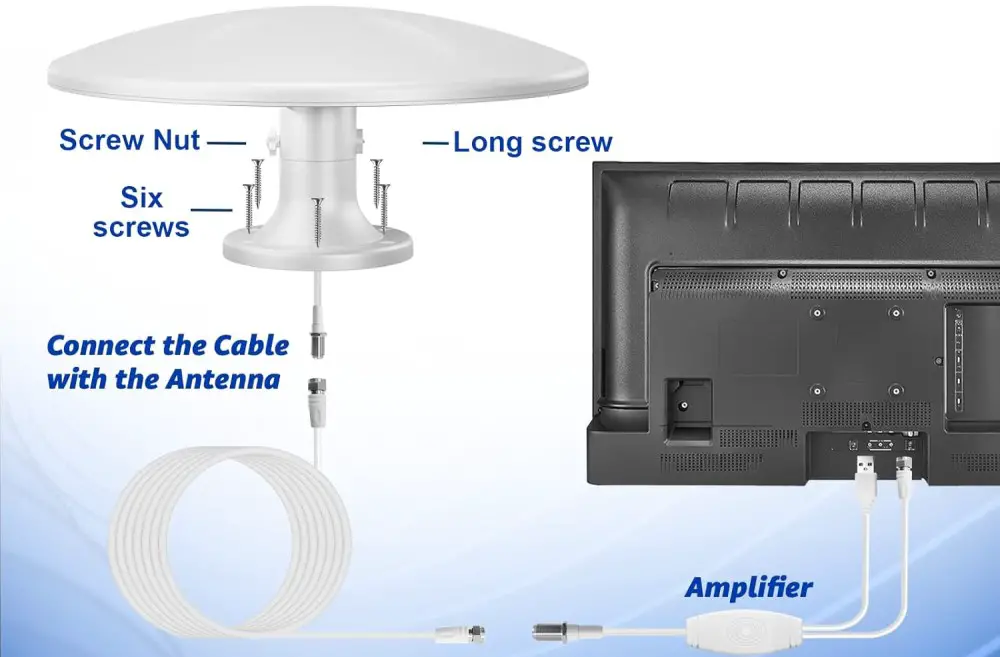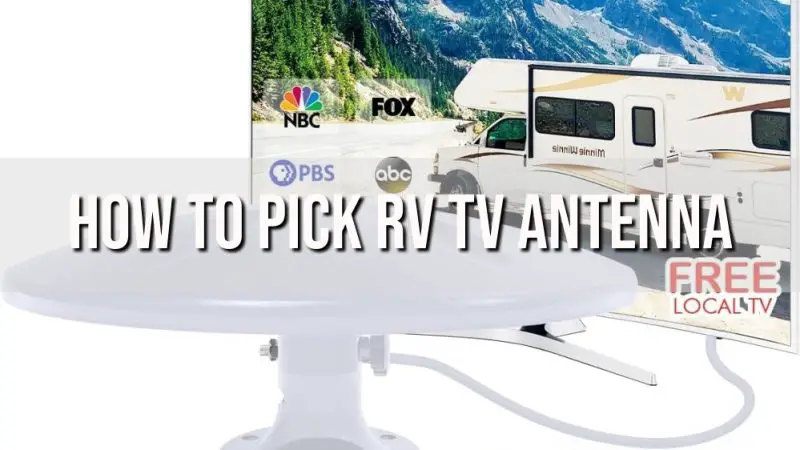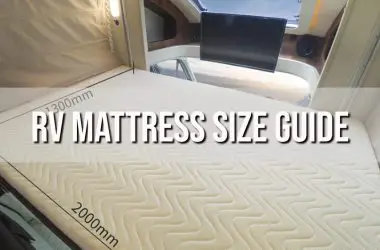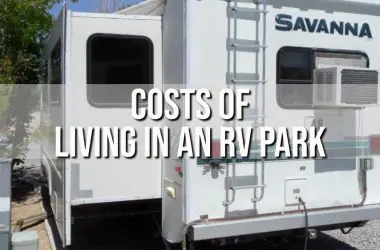Pick RV TV Antenna that can receive over-the-air TV signals is one of the most important purchases for RV owners who want to enjoy free TV entertainment on the road. With the right antenna, you’ll be able to watch local broadcast channels like ABC, CBS, NBC, Fox, PBS and more without paying for cable or satellite service. This allows you to save money while still having access to news, sports, shows and movies.
When selecting an antenna for your recreational vehicle, there are a few key factors to consider including omnidirectional vs directional design, mounting location, range, amplification, and durability. Doing your research to choose the best RV TV antenna for your needs and budget will ensure you can get clear HDTV reception from stations available in the areas you travel.
In this comprehensive guide, we’ll cover everything you need to know about picking the right antenna for TV entertainment on your RV adventures.
Key Takeaways
- Omnidirectional antennas like the Winegard Sensar receive signals from all directions but have shorter range, while directional antennas like the Winegard HD7694P lock in on a specific broadcast tower for longer range.
- Roof mounting provides optimal reception, but ladder mounting can also work well and is easier to set up. Look for durable construction.
- Match the antenna range to your needs. Amplified antennas extend range. HD and 4K models ensure you receive all available programming.
- Carefully consider your budget when choosing an RV TV antenna. Prices range from $30 for budget models to $350 for premium amplified directional antennas.
- Research antennas that offer versatility, easy installation, reliability and good value to ensure you can enjoy free HDTV on the road.
Picking the Right Antenna Design: Omnidirectional vs Directional
One of the first decisions you need to make when selecting a TV antenna for your RV is whether you want an omnidirectional or directional design.
Omnidirectional antennas pick up signals from all directions. This makes them a good choice if you want flexibility to receive programming from varying directions as you travel. Omnidirectional models like the Winegard Sensar III are easy to set up and use – you don’t have to worry about aiming them. However, they typically have a shorter range than directional antennas.
Directional antennas are designed to pick up signals from a specific direction. You aim the antenna toward a broadcast tower location. The benefit is increased range, allowing you to pull in more channels from farther away. But you do have to take the time to point the antenna the right way.
If you frequently camp in areas with strong signal broadcast towers nearby, a multidirectional antenna like the Winegard Sensar III provides plenty of range at an affordable price. For RVing in remote areas far from broadcast towers, a directional antenna like the Winegard HD7694P will enable you to pull in stations from much farther away.

Where to Mount Your Antenna
Mounting location is another important consideration when choosing an RV TV antenna. The highest possible mounting point will provide the best possible reception, minimizing interference.
Roof mounting is ideal since it raises the antenna above surrounding trees, buildings and other obstacles that can disrupt signal reception. Many RV antennas like the Winegard Rayzar Automatic are designed to permanently mount to the roof. This provides excellent height for range and performance. Just be sure the base is sealed to prevent leaks.
If roof mounting is difficult or you don’t want permanent installation, opt for a ladder mount or side mount antenna. Ladder mount models attach to an extendable pole that raises the antenna high above the RV. Side mount units like the KING OA8300 Jack HDTV receive signals when mounted on the side of the RV. While performance is not quite as good as roof mounting, these temporary mounting options can still provide quality reception.
No matter what mounting method you use, check that the antenna base and connections are weatherproof to protect against the elements when traveling.
Match the Range to Your Needs
When researching RV TV antennas, you’ll see range specifications indicating the distance from broadcast towers the antenna can receive signals. Basic models may have ranges of only 30-50 miles, while upgraded directional and amplified antennas can reach up to 150 miles or more.
Think about your typical travel habits and camping destinations to choose an antenna with suitable range capabilities. If you usually stay at RV parks near major cities, a more basic omnidirectional antenna offers enough range at an affordable price. For boondocking in rural areas far from broadcast towers, invest in an amplified directional model with maximum range.
Keep in mind that range is affected by a variety of factors like terrain and obstacles, not just distance from the signal source. Choose a high-quality antenna with some buffer so you can pull in signals even with interference. Amplified antennas also help maximize possible range.
Amplified Antennas for Extended Range
One way to increase the range of an RV TV antenna is to choose an amplified model. Amplified antennas have a built-in signal booster to provide extra power for pulling in stations from farther away.
The Winegard Rayzar Automatic is a popular amplified directional antenna able to receive signal from over 55 miles away. This allows RV travelers to enjoy clear HD programming even in remote areas far from broadcast towers.
If you don’t want a large directional antenna on your roof, consider a compact amplified omnidirectional antenna like the Winegard Elite 7550. The small profile mounts easily to the roof ladder while the amplifier brings in stations up to 75 miles away.
When installing an amplified antenna, be sure to ground it properly to the RV frame. This prevents static buildup which can interfere with electronics. Carefully follow the manufacturer’s instructions for wiring the inline amplifier to the TV connection.

HD Antennas Allow You to View All Available Programming
In order to receive high definition programming, you need an antenna designed for HDTV. Models like the Winegard HD7694P long range directional antenna offer reception of 1080p HDTV broadcasts from both UHF and VHF stations.
Upgrading to an HD antenna enables you to enjoy sports, shows, movies and other programming at the highest quality available. This brings programming to life on new 4K TVs. Plus, HD antennas can pull in more channels at greater distances for excellent performance while RVing.
Some newer antenna models support 4K Ultra HD, the latest broadcast standard. While 4K channels are still limited, a 4K-ready antenna like the Winegard 4K HD7694P will allow you to access these channels now and in the future for top-of-the-line picture quality.
Carefully Consider Your Budget
RV TV antennas vary widely in price based on factors like design, range, amplification, durability and reception quality. As you research different models, carefully balance performance with how much you want to spend.
Budget antennas typically cost $30 to $70. They use basic omnidirectional designs with limited range. But they can provide decent reception when close to broadcast towers. Ideal for intermittent use.
Mid-range antennas cost $70 to $200. They often include amplification and upgraded construction for improved durability and reception. Provide good value for versatility.
Premium antennas run $200 to $400. These high-end models deliver maximum range of up to 150+ miles, HD/4K reception and roof-worthy construction. Worth the investment for frequent RVers.
No matter your budget, look for a well-designed antenna from a reputable brand like Winegard, KING or ANTOP. This helps ensure you get an antenna that provides reliable performance and lasts for many years of RVing.

Key Features to Look for in an RV TV Antenna
When researching and comparing different RV TV antenna options, there are a few key features you’ll want to evaluate for each model beyond just the antenna type and mounting method. Carefully examining how different antennas measure up in these areas will help ensure you select the right antenna to meet your needs and deliver the best performance.
Reception Quality
One of the most important antenna features is reception quality. You want an antenna that can pick up TV signals from multiple directions with minimal signal loss. Omnidirectional antennas generally provide the best reception quality since they receive signals 360 degrees around the antenna. Even as you change locations in your RV, an omnidirectional antenna will not have to be reaimed to maintain signal acquisition.
Models like the Winegard Sensar IV have specialized technology to minimize signal loss as the antenna flexes and adjusts direction. Directional antennas with a narrower focus can also deliver excellent reception quality if properly aimed at the broadcast tower. Look at the reception radius range when pointed at a tower. The greater the radius, the better the antenna is at capturing signal even if it gets slightly misaligned.
Durability
Durability is another key factor since the antenna will be exposed to harsh weather and travel conditions mounted on your RV. Seek out antennas constructed from UV-resistant plastic or aluminum with protective coatings to prevent corrosion. The antenna should be rated for winds up to 100 MPH and heavy rain. RV antennas take a lot of vibration during transit, so look for models with rugged mounting brackets. Waterproof designs prevent moisture damage. King Controls uses Tripot brand mounts known for strength and Winegard anchors antennas in a reinforced base.
Ease of Setup
For convenience, you want an RV TV antenna that can be installed and set up quickly and easily when arriving at a new site. Many models like the KING Quest mount in seconds without tools using built-in jacks, clamps or magnetic backs. Some offer tool-free pole mounting for easy roof access. If installing permanently, the antenna base should seal securely to the roof surface.
For aiming, automatic directional antennas find the optimal position using internal sensors while omnidirectional versions don’t require pointing. At minimum, any aiming mechanisms should be intuitive and easy to adjust manually. The quicker you can get the antenna in position, the sooner you can start enjoying television from new locations.
Compatibility
Naturally the antenna must be fully compatible with the television system and wiring in your RV. Most TV antennas are designed to simply connect to coaxial inputs on the TV or an existing rooftop omnidirectional antenna. Many modern digital antennas have built-in amplifiers that integrate with 12V RV electrical systems to boost signals.
Choose an antenna matched for the programming you want to watch – HD digital antennas are designed for HDTV using 1080p and 4K signals while analog antennas receive traditional NTSC broadcasts. Talk to the manufacturer to ensure complete compatibility with your RV setup.
Value
Finally, you want an antenna that provides good value for the performance. Of course, premium antennas will cost more than basic models, but you want to balance capabilities with budget. Compare warranties between models and brands as well.
Spending more for an amplified directional usually makes sense for RVers who prize long range reception from remote areas. For primarily park camping, an affordable omnidirectional model should suffice. Evaluate your needs and choose the antenna that delivers the right mix of price and performance.
By evaluating these key factors – reception, durability, ease of use, compatibility and value – you can zero in on the perfect TV antenna match for your recreational vehicle to enjoy entertainment on the road.
Top Recommended TV Antennas for RVs
Ready to choose an antenna to enhance TV viewing during your RV travels? Here are some of the top-rated antennas on the market to consider:
Winegard Rayzar Automatic RV Antenna
- Directional amplified antenna
- 55+ mile range
- Automatic scanning finds channels
- HD and 4K reception
- RV roof mount
KING OA8300 Jack HDTV Antenna
- Omnidirectional antenna
- 40 mile range
- Jack mount for easy installation
- Built-in amplifier
- Supports 1080i HDTV
Winegard Sensar IV RV Antenna
- Omnidirectional flexible antenna
- 35 mile range
- Quick no-tool mounting
- Wind-resistant durable construction
- Affordable price
ANTOP AT-800SBS Premium Long Range Digital Antenna
- Flat panel directional antenna
- 150 mile range
- Built-in amplifier
- Snap-on mast for easy mounting
- Support 2160p 4K Ultra HD
Winegard Elite 7550 Antenna
- Amplified compact antenna
- 75 mile range
- Mounts to ladder
- Omnidirectional reception
- Durable snap-on easy installation
This covers some of the most popular and highest performing RV TV antennas across different styles, features and price points. Carefully considering your needs will help you zero in on the right model.
Frequently Asked Questions
Here are answers to some of the most common questions about choosing an antenna for TV reception while RVing:
What is the best RV TV antenna?
For versatility and performance, we recommend the Winegard Rayzar Automatic amplified directional antenna. It provides excellent HD reception from over 55 miles away. Fully automatic scanning makes it easy to set up.
Should I get an omnidirectional or directional antenna for my RV?
If camping near cities, an omnidirectional antenna like the Winegard Sensar works well. For rural areas far from broadcast towers, choose a directional antenna like the KING OA8300 to maximize range.
Where is the best place to mount an RV antenna?
Roof mounting provides optimal reception since it raises the antenna highest. Ladder or side mounting works when roof access is difficult, but may sacrifice some range.
How far will an RV TV antenna pick up signals?
Basic antennas have up to 50 mile range. Upgraded directional and amplified models can receive signals from 150 miles or more away. Match the range to your typical travel distances from TV towers.
Do I need an amplified antenna for my RV?
An amplified antenna provides extra power to pull in more channels from farther away. It maximizes reception when RVing off the grid. Just be sure to properly ground the amplifier when installing.
Do I need an HD antenna for my RV?
To receive high definition programming, choose an HDTV antenna rated for 1080i/1080p reception. For 4K channels, look for a 4K ready antenna. HD antennas provide the best picture quality.
How do I mount an antenna on my RV?
Follow manufacturer instructions for your chosen antenna. Permanent roof mounting provides the best reception. Ladder mounts and side mounts offer flexible temporary installation.
How much do RV TV antennas cost?
Basic antennas start around $30. Mid-range amplified models run $70 to $200. High-end long range directional antennas cost $200 to $350. Match spending to your needs.
What features should I look for in an RV antenna?
Seek antennas with strong 360 degree reception, durability, easy installation, built-in amplifier, HD/4K capability and a reasonable price from a reputable brand.
Conclusion of How to Pick RV TV Antenna
Installing the right TV antenna is a great way to access free over-the-air HDTV programming during your travels. Carefully considering your needs in terms of design, reception, mounting, range and ease of use will help you select the perfect antenna.
Investing in a high-quality, durable RV antenna provides entertainment when camping off the grid. Just be sure to properly ground and install the antenna. Then you can enjoy clear TV reception from available local channels in whatever area you are exploring in your RV!






